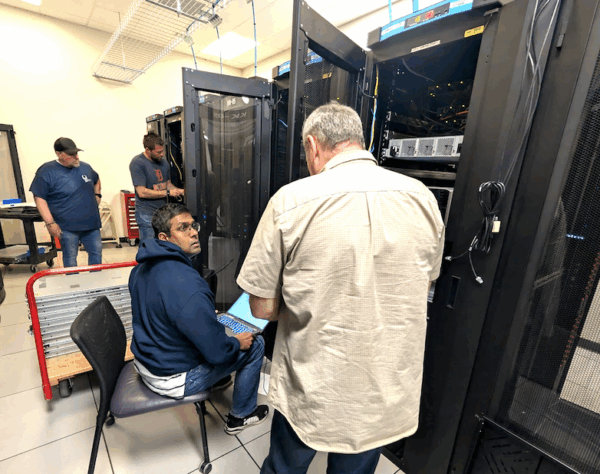
Michigan Medicine had one chance. A hospital’s entire digital core, including real-time care coordination and decades of patient records, had to be moved without disruption. The responsibility fell to a small team working under intense pressure. And they pulled it off flawlessly, not just once but twice: first at UMH-Sparrow, then UMH-West.
Today, the critical systems for both data centers live in one ultra-secure facility: the North Campus Data Center in Ann Arbor. By bringing them in-house, Michigan Medicine gained direct control, building a more reliable digital infrastructure.
Risks to patient care weren’t an option. The two hospitals, the Academic Medical Center (AMC), vendors, and IT professionals coordinated closely. It wasn’t as simple as unplugging and hauling gear. Every facility is unique, and even small differences in power or layout could cause errors or even a full system outage.
Jason Mishka, director of Data Center and Cloud Architecture, explained that the team tackled urgent needs without losing sight of the big picture. “(We) adapted the existing server infrastructure to fit the new data center architecture while maintaining architectural standards.”
Chris Holda, regional chief technology officer, focused on making sure everyone felt supported. He stayed engaged, clearing roadblocks and ensuring the right people had the right information. He stressed, “Transitions of this size are about more than just technology. They’re about people.”
Experts precisely mapped server configurations and storage systems. They modeled risk scenarios and designed for no downtime after installation. Mishka noted the “extraordinary coordination” required, from cabinet layouts and cable connector types to power load distribution.
Then, in less than one weekend per data center, engineers physically moved a total of 185 servers and 106 network devices. They relocated 3.6 petabytes of critical hospital data. In real-world terms, that’s 72 million filing cabinets full of information. All of it is needed to keep hospital systems running, and it moved without a single loss.

On transition weekends, Mishka’s priorities shifted. He ensured their small team had a clear, realistic plan for the first 8 to 24 hours. He emphasized: “We had to carefully manage our resources.”
Steve Reynolds, regional manager for Enterprise Networking and Communications, and Mishka thanked Data Center Services, Network Architecture, and the Enterprise Networking teams. They stressed that the close collaboration was essential in making the complex transition possible.
The work was not just a technical migration; it was a successful reinvestment opportunity. The transition unlocked significant cost savings. “Over $600,000 annually,” Holda shared. The savings were directly invested in expanding the Wide Area Network (WAN).
That expanded 1.2Tbps WAN Network, now known as the UMH Fabric, links UMH-West, UMH-Sparrow, and the AMC. That, along with four additional 100Gbps redundant circuits for built-in failover protection, strengthens connectivity across Michigan Medicine’s hospitals and clinics by providing reliable connectivity to the cloud.
Next, teams are focused on enabling cross-entity communication. Support tools like a single Epic instance, Sectra One, and future cloud solutions are key steps toward a truly unified digital ecosystem.
“This was more than a data center move; it was designed to establish a scalable framework for integration, collaboration, and growth across the organization,” said Reynolds. “Over months of planning, we built strong relationships and eliminated technical barriers.”
Reynolds explained that staying on schedule required confidence: “One of the most pivotal decisions was determining the level of risk we could responsibly accept to maintain momentum.” Clear, thoughtful decisions helped everything move ahead while still putting safety first.
The successful move shows that even large-scale change can feel seamless when done right. Like we say in IT, the quietest days often come from the hardest work.

Great work by Jason Mishka, Steve Reynolds, and all the supporting teams on a smooth and strategic transition. Clear planning and collaboration ensured success. The reinvestment of $600K in WAN expansion and the creation of the UMH Fabric marks a huge step toward a stronger, more connected digital future for Michigan Medicine. A great example of how thoughtful execution can drive meaningful impact. Congratulations!